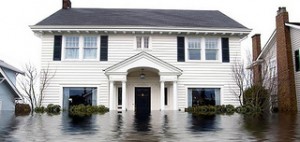Risk of flooding and water damage around the home returns with spring storm season
Posted on Mar 17, 2015According to the National Weather Service, flooding causes more damage in the United States than any other weather-related event. Seventy-five percent of all presidential disaster declarations are connected to flooding and, nationally, more than 100 lives and an average of $4.5 billion in property damages are lost annually due to flood waters.
 Locally, KFB Insurance provides flood coverage through Southern Farm Bureau (SFB) Insurance and the Federal Government’s flood insurance plan. This coverage protects those who reside in flood plains – areas prone to flooding that are often near rivers and creeks that rise. During the past five years 628 Kentucky home- and farm-owners were protected by SFB’s flood coverage and, as a result, received approximately $7.6 million in claims to pay for the repair of their property damages. While most of that total was the cumulative result of several storms occurring over different years, occasionally a single, strong storm powers through the state and causes significant damage to a targeted area. Such was the case in south central Kentucky in May 2010. More than 285 claims and $6.25 million were tallied in that year alone, most of which were caused by the storm in May.
Locally, KFB Insurance provides flood coverage through Southern Farm Bureau (SFB) Insurance and the Federal Government’s flood insurance plan. This coverage protects those who reside in flood plains – areas prone to flooding that are often near rivers and creeks that rise. During the past five years 628 Kentucky home- and farm-owners were protected by SFB’s flood coverage and, as a result, received approximately $7.6 million in claims to pay for the repair of their property damages. While most of that total was the cumulative result of several storms occurring over different years, occasionally a single, strong storm powers through the state and causes significant damage to a targeted area. Such was the case in south central Kentucky in May 2010. More than 285 claims and $6.25 million were tallied in that year alone, most of which were caused by the storm in May.
While KFB is proud to help so many Kentuckians recover after suffering through storm damage, restoring and replacing property is a hefty venture for those without flood insurance. Most home and farm policies do not automatically include coverage for flooding, drain back up or overflow of a sump pump system, so property owners must be aware of flood plains in relation to their homes. Home and farm owners should ask their insurance agent about adding flood, sump pump back-up and drain overflow coverage to their policies to avoid an expensive disaster when storm waters surge.
Even residents living in areas that are not prone to flooding can make small improvements around the home and farm to help prevent surface water damage, which is typically not covered under a standard insurance policy. Listed below are some helpful tips for making a property more water resistant: - Redirect downspouts away from the foundation of the home and extend the tubing to carry the water further away than the typical gutter system allows. - Keep all gutters and downspouts clear of debris that will cause the roof-lining troughs to fill with excess water, overflow and fall instead onto areas close to the foundation. - Reshape landscaping around the foundations to slope downward, directing water away from the house. - Caulk any cracks seen around the foundation that might allow seepage into a basement or crawlspace. - Unfinished basements walls can be sealed internally with specialty applications found at most home improvement stores, but may require continual review and maintenance over time. - Install a sump pump and foundation drain system to force water out of the area in and directly under a house.
Despite their best efforts, though, homeowners cannot always prevent water damage from occurring. For times like those, it is wise to have copies of important documents and photos of your home, farm and other possessions on file somewhere off site, like a bank safety deposit box, for reference and insurance purposes if personal property is destroyed or washed away.
Of course, flooding can do much more than just damage personal property – floods occasionally claim lives, too. The National Weather Service points out that just six inches of water can sweep a person off of his or her feet, and that two feet of water is enough to lift and move a car, even an SUV. More people drown in their cars than anywhere else during a flood. If the water covering the road is more than a few inches deep, it is best to find an alternate route – even if it takes longer to reach the destination. What appears to be a short drive through rising waters could end up preventing more than just a person reaching the other side of the road – it could cost a life.
When storms hit Kentucky, it is important to follow news updates on the television or radio and pay attention to the warnings that are issued. In preparation for Flood Awareness Week (March 15-21) and Severe Weather Awareness Month (March), KFB advises Kentuckians to create emergency plans and kits for situations like floods, tornadoes and other natural disasters. To learn more about how to start a plan and what to include in an emergency kit, visit ready.gov.
Tagged Post Topics Include: Flood, Flood Awareness Week, Flood Insurance, Flood Plain, Insurance, March, National Weather Serrvice, Rain, Safety, Severe Weather Awareness Month, Southern Farm Bureau, Storm, Storm Damage, Thunderstorm, Tornado, Water, Water damage, Weather
Comments